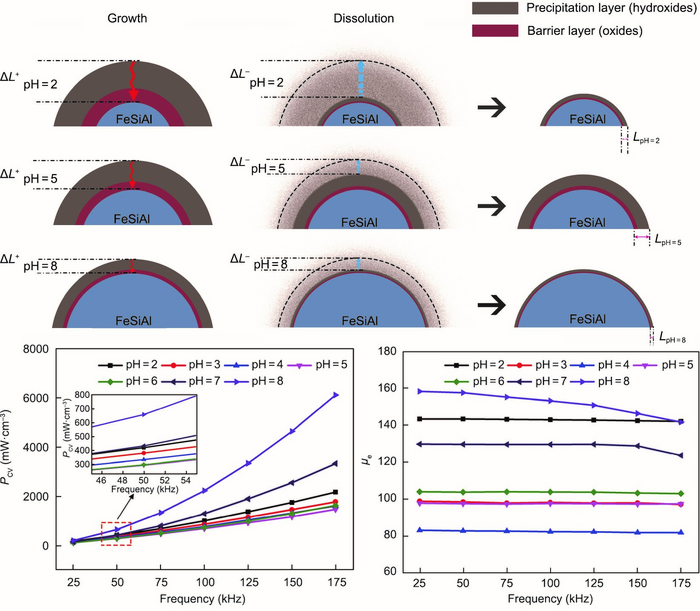A study on sodium nitrate passivation as a new insulation technology for soft magnetic composites created by a team led by Professor Mi Yan and Dr. Chen Wu was recently published in Engineering.
 The insulation coating exhibits a bi-layered structure containing an oxide barrier and a hydroxide precipitation layer. The growth and the dissolution rate of the coating vary with the pH value of the NaNO3 passivation solution, resulting in different coating thicknesses, which are correlated to the magnetic performance of the corresponding soft magnetic composites. Image credits: Prof. Mi Yan
The insulation coating exhibits a bi-layered structure containing an oxide barrier and a hydroxide precipitation layer. The growth and the dissolution rate of the coating vary with the pH value of the NaNO3 passivation solution, resulting in different coating thicknesses, which are correlated to the magnetic performance of the corresponding soft magnetic composites. Image credits: Prof. Mi Yan
Soft magnetic compounds, which are made based on metallic magnetic powders through insulation coating, compaction, binding, and annealing, act as important basic materials in different fields that include transportation, energy, national defense, and aerospace.
Owing to the low-electrical-resistivity nature of the soft magnetic alloys, it is difficult to control the loss of eddy current, which has turned out to be an obstruction for high-frequency applications. Phosphorization technology is generally used to produce insulation coatings for industrial production and scientific research.
The resultant phosphate coating, however, tends to decompose at over 600 ℃ and miss the insulation impact at higher temperatures. It is important to form new insulation technology to create coating layers with robust adhesion, along with suitable thermal stability and electrical resistivity for high-frequency applications of soft magnetic composites.
For soft magnetic composites, the team of Professor Yan and Dr. Wu has suggested sodium nitrate passivation as a new insulation technology. Depending on methodical compositional and microstructural examinations, evolutions of the coating in various pH settings have been disclosed, along with the coatings’ growth mechanisms revealed via thermodynamic and kinetic analyses.
The study reveals that the insulation coating achieved with an acidic NaNO3 passivation solution with pH = 2 comprises Fe2O3, SiO2, Al2O3, and AlO(OH). The outcome of the large growth rate of the coating layer is because of the strong oxidation competence of NO3− in an acidic environment—at the same time, the dissolution rate of the passivation layer is also high due to the high H+ concentration, which leads to the passive layer’s small thickness at pH = 2.
Using increased pH to 5, the Fe2O3 transforms into Fe3O4 with enfeebled oxidation capability of NO3−. In spite of the slightly reduced growth rate of the passivation layer, the H+ concentration reduction also inhibits its dissolution well, leading to the maximum thickness of the insulation coating for considerably increased electrical resistivity and ideal alternating current (AC) magnetic performance (μe = 97.2, Pcv = 296.4 mW/cm3 under 50 kHz and 100 mT).
Increasing the pH to 8 considerably deteriorates the oxidability of the NO3−, leading to only Al2O3, AlO(OH), and SiO2 in the passivation layer with retarded growth and much decreased thickness. Furthermore, corrosion happens in some areas of the magnetic powder surface, resulting in slow performance.
The NaNO3 passivation technology formed in this study is expandable to other magnetic alloy systems and also sets the concrete groundwork for the establishment of new and advanced insulation coatings with the use of oxidizing agents like superoxide, nitrite, and permanganate.
Journal Reference:
Yan, M., et al. (2022) Sodium Nitrate Passivation as a Novel Insulation Technology for Soft Magnetic Composites. Engineering. doi.org/10.1016/j.eng.2022.01.016.